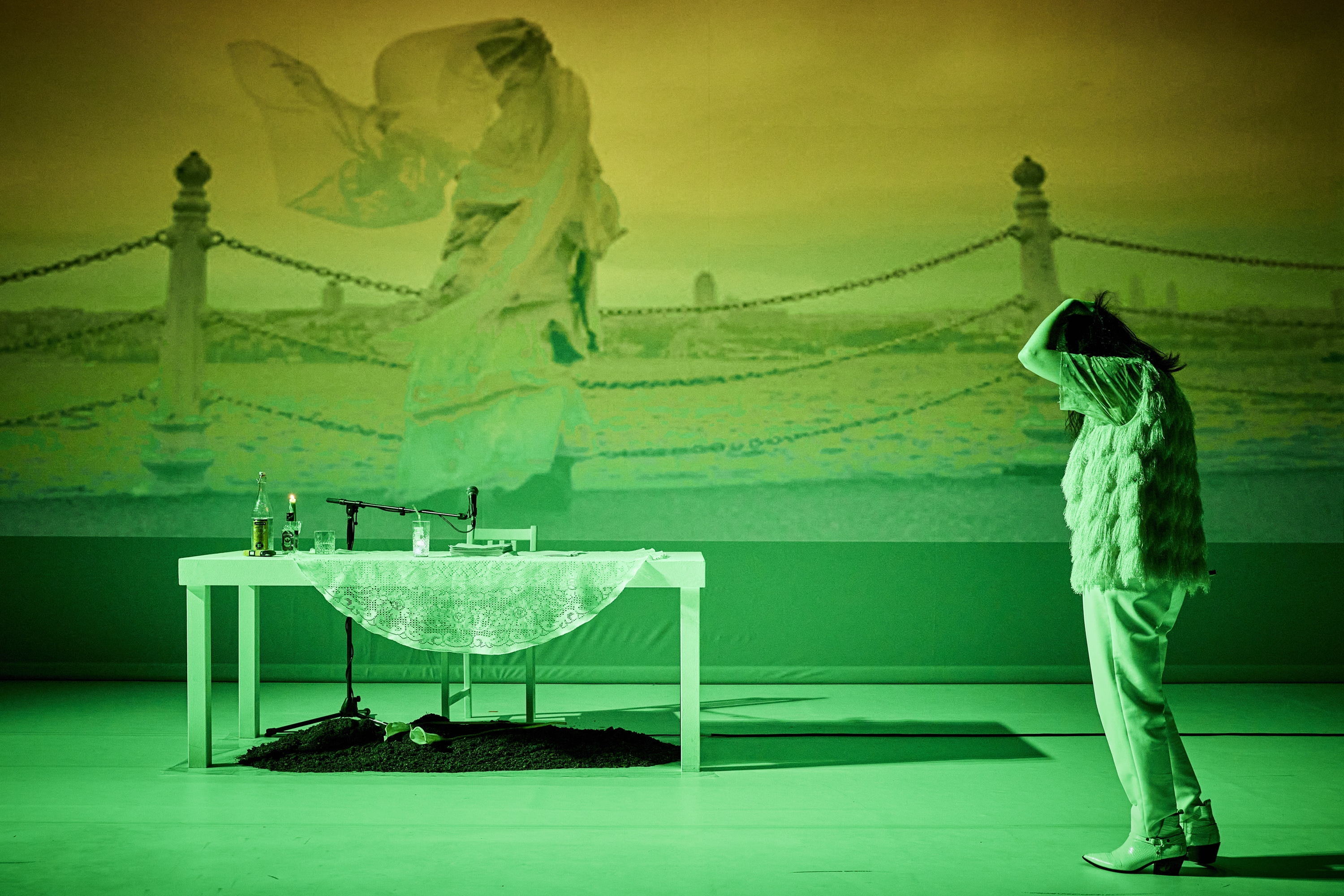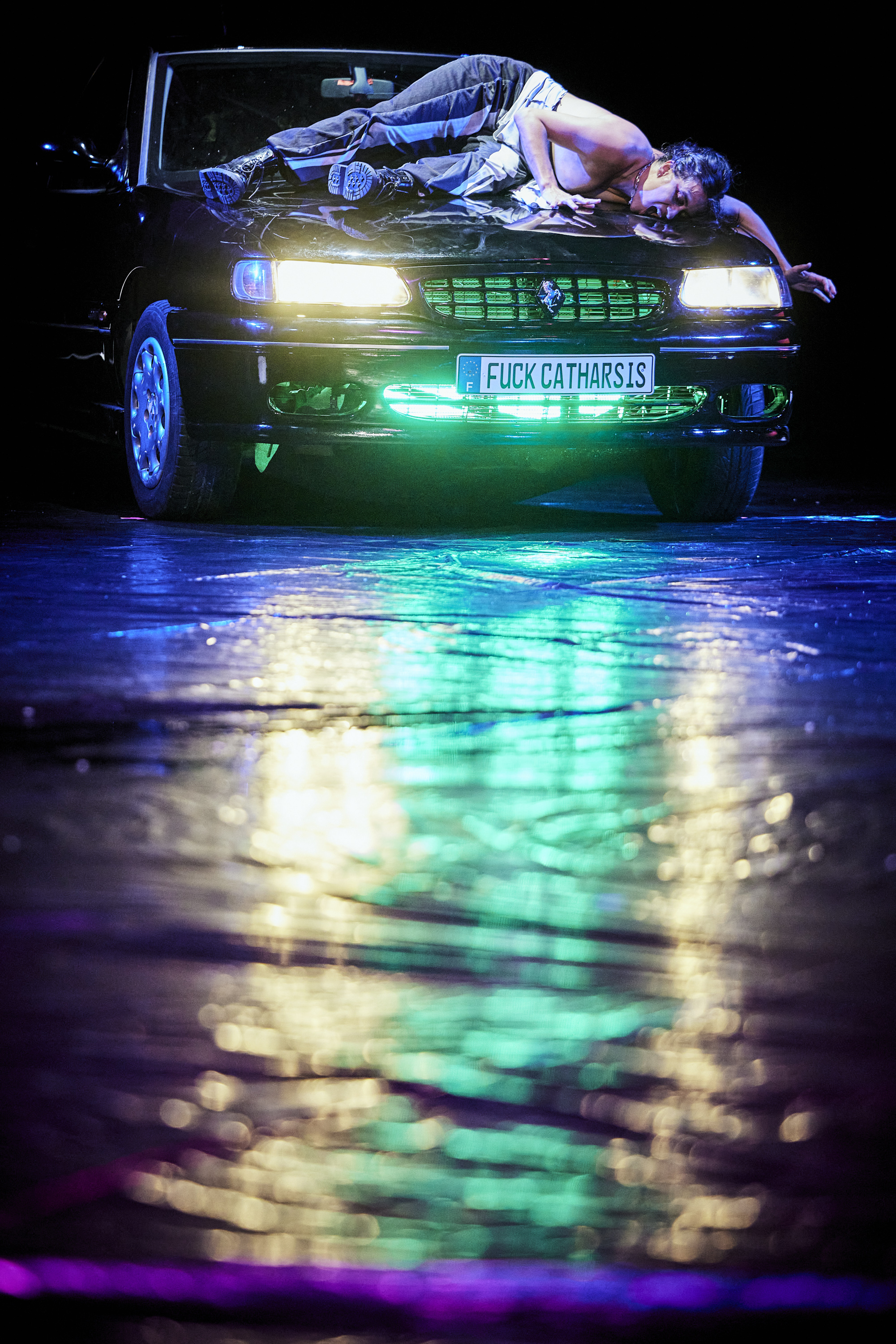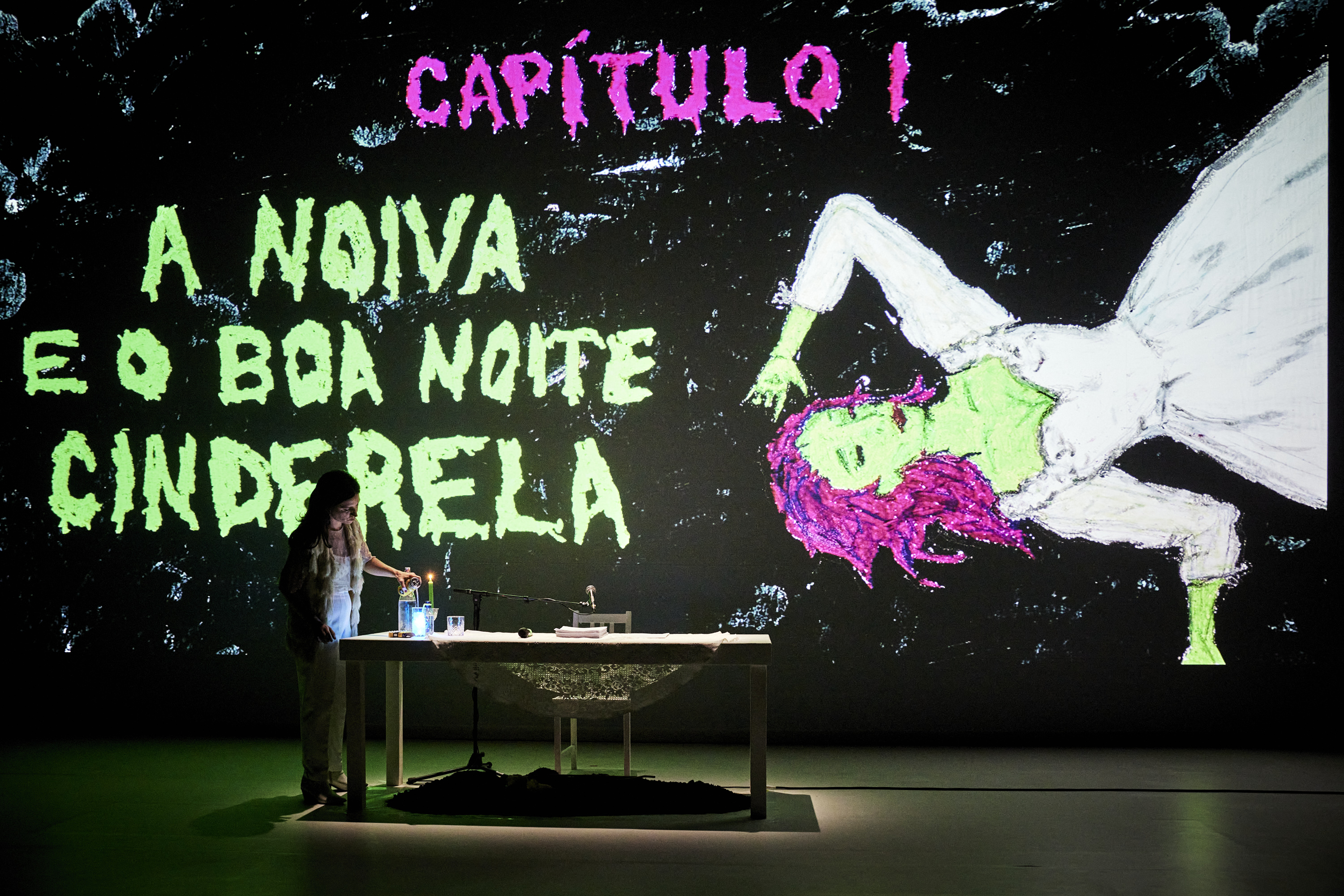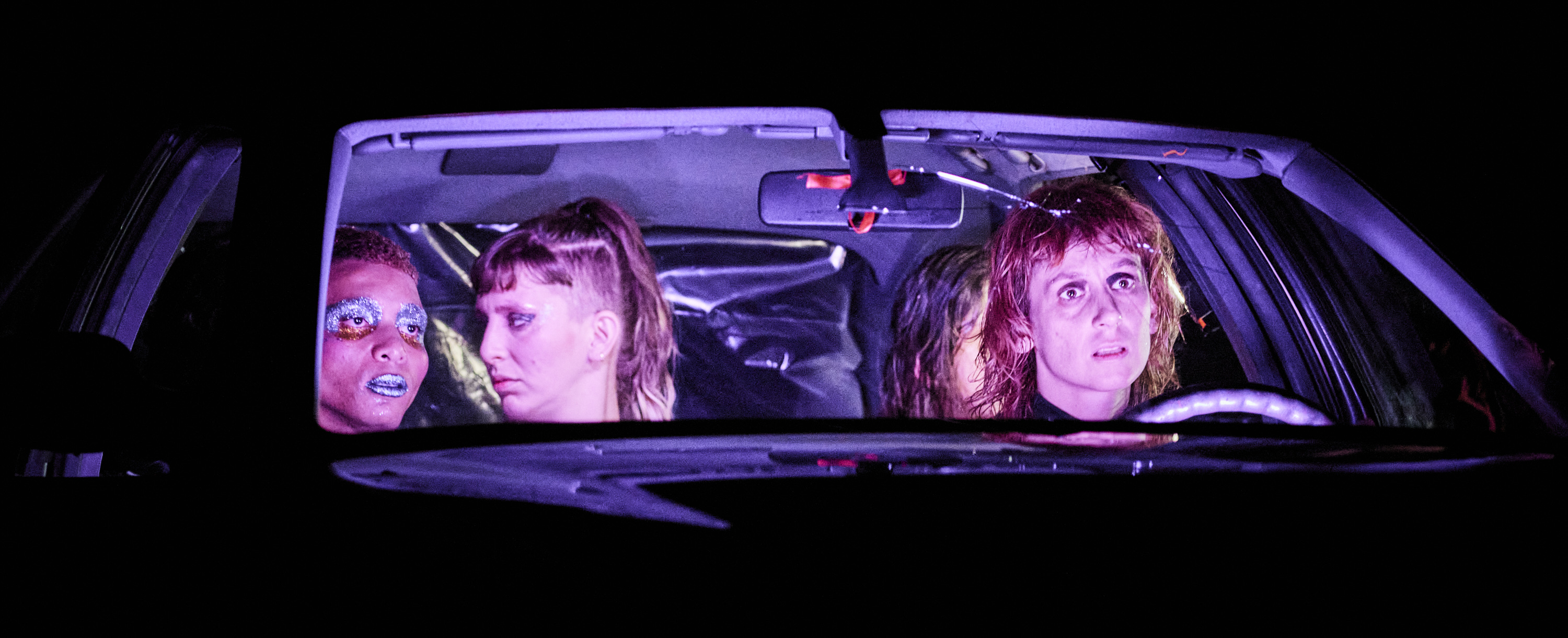
In the Making : Carolina Bianchi on Cadela Força Trilogy
A discussion with Carolina Bianchi about emotional risk and why she’s pushing theatre into new places to explore questions about violence against women.
Chapter 1 of Brazilian author/director Carolina Bianchi’s Cadela Força Trilogy is a fearless piece of theatre about gender-based violence. It tackles questions of femininity, victimisation and representation by playing with the limits of reality and emotional risk.
The show begins as kind of performance-lecture. Bianchi steps on stage, mic in hand, and starts with a short renaissance art-history lesson. It’s the first in a series of stories about sexual assault, violence against women and art. But when Bianchi reaches the subject of performance artist Pippa Bacca—something shifts. Bacca was sexually assaulted and murdered in 2008 while performing a work about the belief in human kindness. In a desperate response to Pippa Bacca’s story Bianchi ingests drug known in Brazil as ‘Goodnight Cinderella’ and continues her presentation while the drug takes effect. Soon, she’s slumped on a table—a dead weight. From there, the curtain falls away and the show expands. Performers carry Bianchi’s inert body through a fever dream—a world where past and present collapse.
Bianchi has been using her work to talk about violence for years. In this interview she explains why, with Cadela Força, she decided to approach these questions from the blurred edges. And why she's going beyond a reproduction of violence on stage into a more unresolved “grey zone” to work through themes of trauma, subjectivity and memory.
Q. Violence against women. What was the genesis of your play, with its harsh and intense subject, so difficult to tackle?
A. I’ve explored the question of violence for many years, of sexual violence, of violence against women. It was already a topic that ran through some of my older works, especially Mata-me de Prazer (Kill me with pleasure) in 2016, or Lobo (Wolf) in 2015. I looked into female artists who worked on the question of violence, and who were also victims of it, as in Lobo, where I tackle the trial of Italian painter Artemisia Gentileschi, who was sexually assaulted at a very young age. But in the triptych Cadela Força, I wanted to approach this sensitive subject through the prism of art and artistic practice in a more direct way.
If, in my earlier works, the spectre of violence against women was always present, here and now, I dare say those words clearly and, for the first time, get straight to the heart of the matter. It’s an eminently complicated exploration I began during a Masters in Amsterdam where, unlike in previous years, I’d separated the work on dramaturgy I do with my company and the work of research and writing, which is more of a lonely endeavour. Then the Covid period forced me to do some introspection and, along with my collaborators, we felt the need to never let our connection break and to keep communicating and working together. We shared a lot, exchanged a lot.
It was primordial for me not to be alone to tackle this many-headed subject. Yet curiously, the result was the decision that I would be alone on stage for the first fifty minutes of Cadela Força. It’s the part we’re presenting at the Festival d’Avignon, entitled A noiva et Boa noite Cinderela.
I tackle the subject head-on, in a genre close to theatre-conference. It’s very formal, it’s a posture that allows me to question my own role within my work. Of course, I’ve always written and directed, but “what happens when I perform my own plays?” Now I want to answer that question.
Q. You mentioned a many-headed subject, full of enigmas, but also the subject of your research… They echo each other. The question of an attempt to tackle an infinite, never-ending subject, seems to be at the heart of your practice.
A. I’m in a position of exploration with this research on all the kinds of violence against women, be they physical, sexual, psychological. It’s an open form of questioning, to which there is no answer. I’m not trying to give an investigation report or to reproduce or replay those acts of violence. Quite the contrary.
What seems complicated is to be in a state of confusion right from the start. The subject of violence, from the act itself to the way it is experienced, contains an irresolvable part, one it is impossible to talk about. For many, if not for all, it is a real enigma. The play isn’t trying to find meaning within this confusion. Rather, we explore it, dive into it. To be exhaustive, and to find something universal which we all share, we add layers of meaning, stories, and symbols.
The play opens with the portrait of performing artist Pippa Bacca and the presentation of her work Brides on tour (2008). It was a long-term performance by two women artists travelling through Europe, from Italy to Israel, wearing wedding dresses. The idea was to operate “a wedding between the peoples met,” a project of peace which would have ended with the exhibition of their dresses, stained from all their travels, in a Jerusalem gallery. When she got to Turkey, Pippa was raped and killed.
Q. To speak about women, and women artists, is also an homage to their lives, their commitment, and a way to show art as a risk.
A. By opening my play with her story, I’m not only narrating the violence Pippa suffered, but also the story of her artistic gesture, and of performance in general. Gender-based violence is a thorny subject which always questions femininity, victimisation, and representations of the feminine. Its edges are often blurry, and the questions raised often left unanswered. While I can’t imagine embarking on a performance similar to Pippa Bacca’s, I’ve realised I had to challenge myself with a powerful performative act on stage. Something that would not quite belong to theatre and imagination anymore, but that would be concrete, hyper real, playing with the limits of risk.
I call it the “resurrection” of a performance. That’s why I swallow a sleeping pill we call “Boa noite Cinderela” in Brazil. It’s the same drug which is used in bars by sexual predators. It’s a perfectly controlled gesture. I’m monitored and surrounded by people before, during, and after the scene. The risk is much less physical than it might seem, and this act is far from being at the heart of what I’m trying to say.
In the concept of resurrection, you first have the idea of “life after life,” what is left in us after experiencing a situation. It could be the residue of our memory. There are the archives and texts we collected, of course, but above all the memories and feelings, both collective and individual, subjective… That’s why I felt the need to experience a powerful performative gesture, akin to the work of those women who’ve always inspired me.

Cadela Força Trilogy, Joana Ferraz. PHOTO: Christophe Raynaud de Lage

Carolina Bianchi in Cadela Força Trilogy Chapter. PHOTO: Christophe Raynaud de Lage
The performance allows me to tackle violence from a different angle: I’m in the middle and I explore the persistence of my own memory. Because it’s important to mention that acts of violence and the traces left by those acts remain difficult to apprehend, I face the unresolved, this grey zone. I exist both within this performative gesture, which belongs to a unique time, its own time, and within drowsiness, which is a specific temporality, both irreproducible and impalpable. I’m there without being there.
Just like memory always plays with reality and duration, and explores the borders of confusion and subjectivity. The flaws in memory open a breach on which imagination feeds. I can then fill in the holes in reality with imagination, the imprecisions of memory with fantasy. And since we’re at the theatre above all, I’m not embarking on an investigation to uncover the truth. On the contrary, my exploration is factual, human, sensorial. The medium of theatre is, I think, the most apt to contain this kind of stories.
Q. You’ve mentioned risks. What kind of risk do you mean?
A. The idea is to attempt to resurrect a personal memory buried because of how violent it is. Cadela Força is an attempt to find a language to tackle all that violence. I’m not immune to failure. That’s the difficulty of this kind of subject. What happens after a rape? After a feminicide? I try to explore the chasm between life and death, sleeping and death.
Once the conference-theatre is over, the speaker falls asleep at her table, and the play enters a different theatricality. The minimalist white space turns into visual chaos, the irruption of the collective takes the performer out of her loneliness. Bodies fill the space, which turns into a shapeless matter, an accretion of objects and meanings, on the edge of a nightmare…
The concept of risk isn’t so much for my physical body, because I’m always surrounded, but in the very tackling of those subjects. There’s a high emotional risk. Luckily, at the theatre, humour can stand alongside darkness, alongside the darkest actions of humanity. It’s also a risk in the sense that this play doesn’t solve any problems, doesn’t give any answers, but instead creates more confusion. It lifts the veil on a huge enigma.
Metaphorically, we’re trying to stir some taboo words to bring them back to the surface, we’re going through the garbage that’s been accumulating right under our noses. The group, the collective, is there to offset my failures, the faults in my memory, since I momentarily left thanks to my artificial sleep. The story can continue to be experienced without my being entirely there.
It’s about speaking about the same thing as in the first part but in a different way, a more choreographic way, as if it were but a trip in my head. Like the circles of Dante Alighieri’s Hell. What happens when memory fails us, when its edges become blurry? The scenography turns to disorder, our approach becomes sensorial, timelines become entangled. Future and past come together, as in a traumatic event. I’ll never know. But my sensations, and a few perceptions, remain.
This interview originally appeared on Festival d'Avignon website. Interview conducted by Moïra Dalant and translated to English by Gaël Schmidt-Cléach.

Cadela Força Trilogy Chapter I by Carolina Bianchi and Cara De Cavalo—$62—$79
A show that is both a fever dream and worst nightmare, beautiful and grisly.